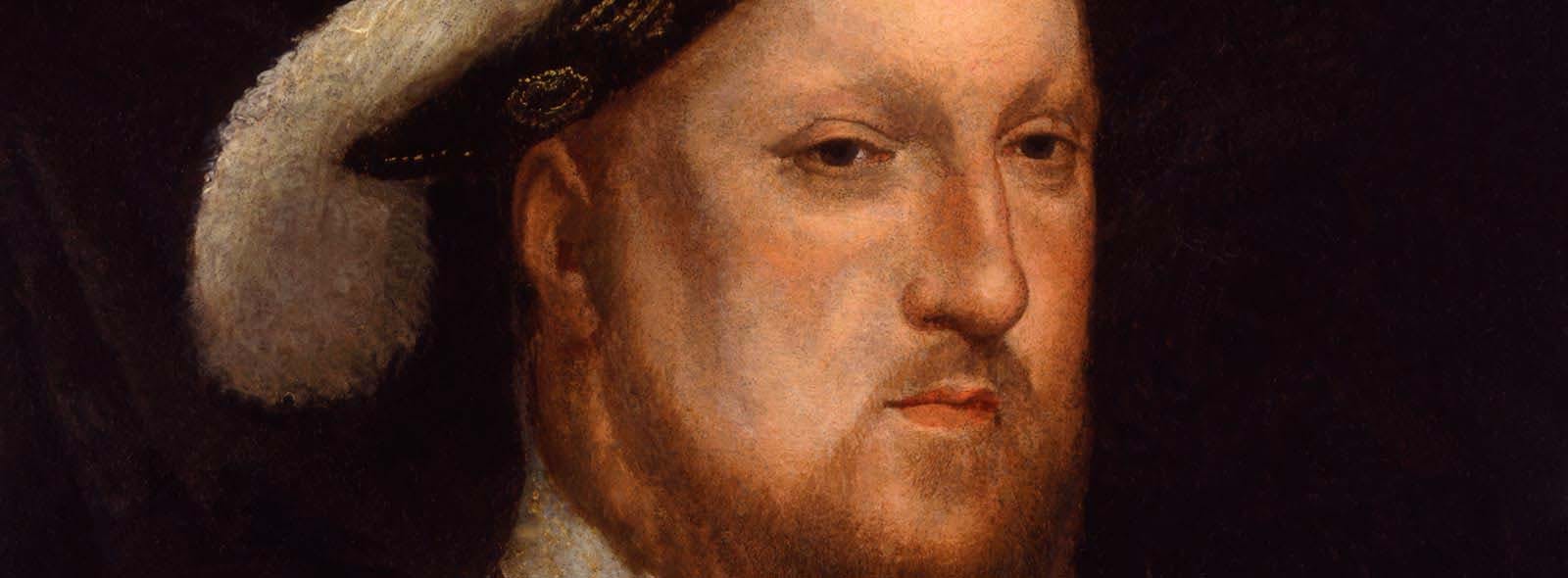
Who was the real Henry VIII?
Henry VIII’s reign (1509-47) is usually remembered for the King’s six wives and his legendary appetite. Infamously, he sent two of his queens, Anne Boleyn and Catherine Howard, to their deaths on the executioner’s block at the Tower of London. But it is too easy to think of Henry VIII simply as the terrible monster of his bloated old age, shuffling painfully through Hampton Court Palace.
Henry was once a vivacious little boy, adored and indulged until his elder brother Arthur’s death placed a huge, unexpected burden on this second son. Two years later Henry’s beloved mother Elizabeth of York died and his protective father Henry VII kept his precious heir cossetted and restricted.
Many of Henry's actions as King still resonate today. It could be said that in many ways Henry VIII made our modern world. The break with Rome, the Reformation and the Dissolution of the Monasteries had profound and lasting effects.
Henry VIII was a paradox: a strong ruler, yet an anxious, insecure man. Henry was a ‘golden youth’ before a great series of losses and misadventures took their toll. Perhaps these go some way to explain his behaviour and gradual decline.
Header: Henry VIII (detail), after Hans Holbein the Younger, probably 17th century, based on a work of 1536, © National Portrait Gallery
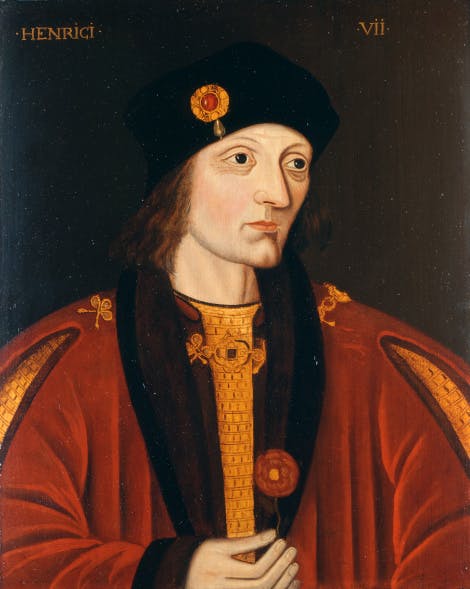
Image: Henry VII, by an unknown artist in the late 16th or early 17th century, based on a work of c1490-1500, The Royal Collection © Her Majesty Queen Elizabeth II, RCIN 404743
Who were the Tudors?
Henry Tudor, Henry VIII’s father, was one of the last surviving heirs of the ‘House of Lancaster’, one of two powerful medieval royal families who fought over the throne for generations, during the Wars of the Roses.
Henry VII seized the throne at the Battle of Bosworth in 1485, defeating Richard III, the last monarch from the ‘House of York’, the Lancastrians’ great rivals. The Tudor period had begun.
As Henry VII, the new King sought to bring an end to war by marrying Elizabeth of York, while his clever political and financial management returned England to some sort of stability.
Read more: Henry VIII's children

Image: The Family of Henry VII with St George and the Dragon c1503-9. The unknown painter included Henry's siblings who died at birth or soon afterwards. © Royal Collection Trust / © Her Majesty Queen Elizabeth II, RCIN 401228
Henry VIII's birth
Henry VIII was born at Greenwich Palace on 28 June 1491. Little official attention was given to his birth. While his parents, Henry VII and Elizabeth of York, would have been pleased to have another male heir, the infant Henry was just the spare.
All hopes for a Tudor dynasty rested on Henry's elder brother, Arthur (1486-1502) — the heir to the throne. The younger Henry was destined for a pleasurable life as a prince.
How many siblings did Henry VIII have?
Henry VIII had three siblings: his elder brother Arthur and two sisters, Margaret (1489-1541) and Mary (1496-1533).
Both of Henry's sisters became queens: Margaret married James IV of Scotland in 1503 and Mary married Louis XII of France in 1514. When he died, Mary married Charles Brandon, Duke of Suffolk.
The heir and the spare
At five, Arthur was growing into a fine boy, clever and sporting. In 1501 he married Katherine of Aragon, a Spanish princess. As the younger brother, the 10-year-old Henry escorted the young Katherine. He later described her to his father as ‘a beautiful creature’.
Little is known about the relationship between Henry and Arthur, although it is known that Henry kept his late brother’s Garter robes throughout his life. They were raised mostly apart.
Soon after Henry’s christening he was sent to join his sister Margaret at Eltham Palace to be raised in a predominantly female household, presided over by his doting mother, Elizabeth of York.
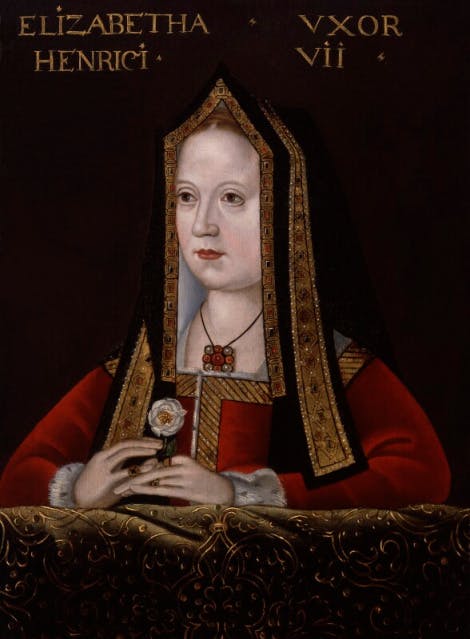
Image: Elizabeth of York by an unknown artist, late 16th century, based on a work of circa 1500. © National Portrait Gallery, London
Henry becomes heir to the throne
Suddenly, Arthur fell ill and died on 2 April 1502. Henry was 10.
Life changed overnight for Prince Henry. He ceased to be in an all-female household. His father appointed several new male attendants to help prepare the boy for his new role. Henry’s mother seldom visited. She was expecting another baby although the pregnancy was not progressing well.
In February 1503 Elizabeth of York gave birth prematurely at the Tower of London. Within a few days, both she and her infant daughter died, plunging the family into fresh grief. An illuminated manuscript from the time, once belonging to Henry VII, shows Prince Henry weeping into the sheets of his mother’s empty bed.

Image: Portrait of Henry VIII (1491-1547) by an unknown artist, c1509, The Berger Collection at the Denver Art Museum, USA / Bridgeman Images
A protected prince
Two years later, just before his 13th birthday, young Henry joined the royal household. But rather than encouraging his son’s independence, his father proved over-protective of his remaining son and heir, scrutinising every aspect of his upbringing. Whenever the Prince wished to go out to hunt or joust he had to be accompanied at all times.
This must have been as frustrating for the young Henry as it was for others at court. The Spanish ambassador complained that no-one could see the Prince, and that he was ‘kept like a girl’.
But as he grew into a young man, Henry flourished. Charming and accomplished, he wrote music and poetry and threw himself into all the sports of the Tudor court – hunting, jousting, wrestling, swordplay, hawking and tennis. He was described as ‘a golden prince’ and a ‘universal genius’.
The new King Henry VIII of England
The physical embodiment of England's new beginning
On Henry VII's death on 21 April 1509, Prince Henry became Henry VIII. He was the first adult prince to inherit the throne peacefully from his father in almost 100 years.
Henry was only 17, but his youthful vigour and his dual Yorkist and Lancastrian blood made him the physical embodiment of a new beginning for the English nation.
How tall was Henry VIII?
Henry VIII was 1.87 metres tall (6 feet 2 inches). He towered over many of his contemporaries: the average Londoner measured 1.70 metres (5 feet 7 inches).
The King's height was noted by contemporaries, who described him as 'above the usual height, with an extremely fine calf to his leg'.
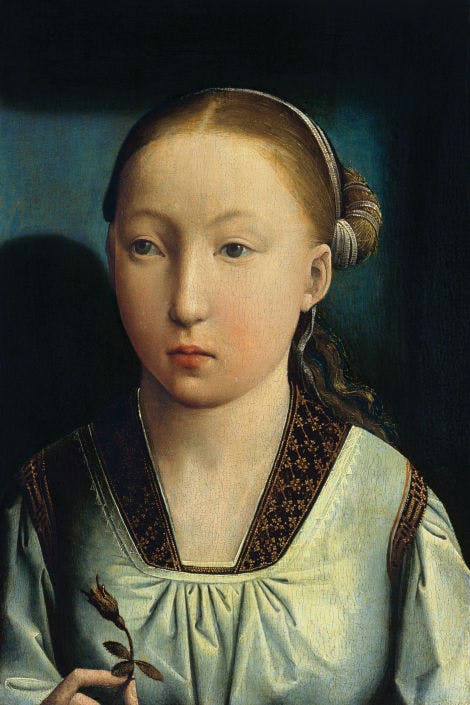
Image: Portrait of a Spanish Infanta, possibly Katherine of Aragon, by Juan de Flandes, c1496, © Museo Nacional Thyssen-Bornemisza, Madrid
Henry and Katherine of Aragon (married 1509-33)
Virtually Henry’s first act as king in 1509 was to marry the Spanish princess Katherine of Aragon. After her brief marriage to Henry’s older brother Arthur in 1501, Katherine had been left stranded in England while wrangling over the final part of her unpaid dowry continued.
At 23, she was over five years older than Henry, and we know little of what they felt for each other. Perhaps they were in love, perhaps they had a mutual affection based on their new freedoms, released from the restrictions imposed by Henry’s controlling father. Certainly, Katherine’s family connections were an asset for a young king intent on making his mark in Europe.
The magnificent coronation
As was the custom, set by generations of medieval monarchs, Henry spent the night before his coronation at the Tower of London, before processing to Westminster Abbey. The Tower was the nation's oldest and most symbolic royal residence. Taking control of the Tower meant taking control of the country.
On midsummer’s day 1509, Henry and Katherine were crowned before a multitude of adoring Londoners in Westminster Abbey.
The streets of London were decorated with tapestries and cloth of gold, and the magnificent spectacle set the tone for Henry’s reign. Henry and Katherine spent the next few months in a constant round of parties, tournaments and feasts.
Did you know?
As partners, Henry and Katherine were well-matched. They shared a similar education and piety, loved finery and display, rode and hunted together.
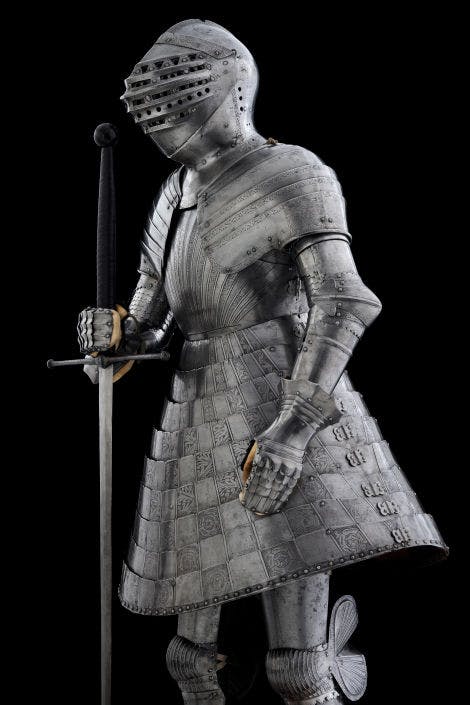
Image: Henry VIII's tonlet armour, © Royal Armouries
'The best-dressed sovereign'
Everywhere he went, Henry surrounded himself with rich displays of gold and silver. ‘He is the best-dressed sovereign in the world: his robes are the richest and most superb that can be imagined.’ [Sebastian Giustinian, Venetian Ambassador, 1519]
Naturally, Henry's armour made a powerful statement, too. This Tonlet armour (pictured) was put together in a very short space of time by the armourers at Greenwich for the King to wear at the Field of Cloth of Gold in 1520. The masterful armourers adapted a number of existing pieces and created this beautiful suit.
Etched decorations include figures of St George, the Virgin and Child, and Tudor roses. The armour also reflected Henry's fashion sense; the shape of the breastplate and tonlet (skirt) mimic the jerkin with flared skirt popular during his reign.
Henry VIII's foreign policy
Henry VIII had been brought up to hero-worship earlier English kings, such as Henry V and Richard the Lionheart. Henry believed he too had a royal duty to lead his nation to glory in war, against traditional enemies, especially the French. Henry VIII believed he could even rekindle England’s ancient claim for the throne of France.
In 1513, the King led an army across the Channel and captured the French town of Thérouanne and city of Tournai.
Such military victories were limited and expensive. They were designed to force the enemy to the negotiating table to agree to a favourable peace treaty.
In 1520, Henry and Katherine travelled to France for a two-week summit with the new young French king, Francis I.
The ‘Field of Cloth of Gold’ was one of the most extravagant and expensive European royal festivals in history.
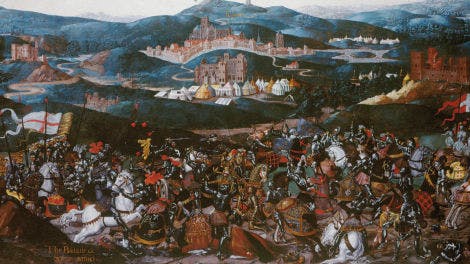
Image: The Battle of the Spurs, c1513, by an unknown artist, Royal Collection Trust / © Her Majesty Queen Elizabeth II, RCIN 40678
Henry's Image
The Battle of the Spurs
The Battle of the Spurs is a painting at Hampton Court commemorating Henry VIII’s early military triumphs against France in 1513.
The King is shown on horseback leading a cavalry charge, and taking the surrender of the Chevalier Bayard. Except Henry wasn’t on the battlefield: the King’s Council refused to let him take part.

Image: The Field of the Cloth of Gold, c1545, by an unknown team of artists. Royal Collection Trust / © His Majesty King Charles III 2024, RCIN 405794
Field of Cloth of Gold
If Henry could not seize the French crown by force, he could instead place England, and the Tudors, ‘at the heart of Europe’.
This painting shows Henry meeting Francis I of France in 1520, amidst lavish temporary palaces and golden tents, jousting tournaments, indulgent banquets and wine fountains.
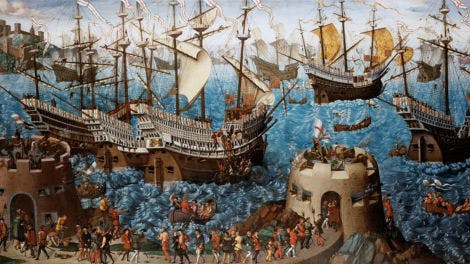
Image: The Embarkation of Henry VIII at Dover c1520-40, by an unknown team of artists, Royal Collection Trust / © Her Majesty Queen Elizabeth II, RCIN 405793
The Embarkation of Henry VIII at Dover c1520-40
This painting probably depicts Henry VIII's departure from Dover for the ‘Field of Cloth of Gold’ in 1520.
It is not a literal account of the King’s journey, but a celebration of Henry’s coastal fortification and ship-building programme, which greatly expanded the Royal Navy.
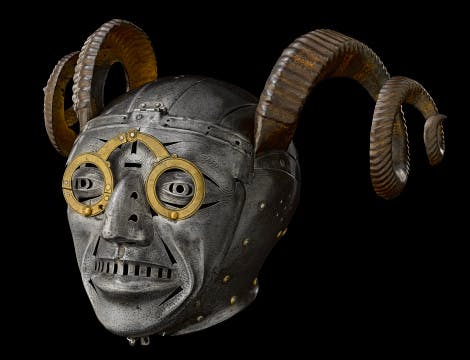
Image: This famous 'horned helmet' (pictured) made by Konrad Seusenhofer is all that remains of a suit of armour given to Henry by the Holy Roman Emperor Maximilian I in 1514. It’s likely that the horns were added later. © Royal Armouries
'Horned Helmet'
Henry VIII established a royal armoury at Greenwich. The King’s suits of armour, for battle and for tournaments, combined the latest technology but were also stylish and elaborate, with engraved decorations in silver and gold. Fabulous gifts of armour from one ruler to another were a great way to flatter a potential ally.
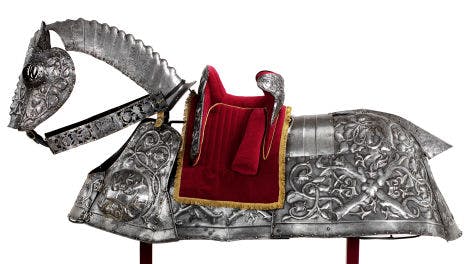
Image: Horse armour, also known as the Burgundian bard, 1510, of Henry VIII, by Guillem Margot, © Royal Armouries
Horse armour, also known as the Burgundian bard
Along with his gift of a suit of armour and horned helmet, in 1514 Emperor Maximilian I also presented Henry VIII with an even more fabulously embossed horse armour, or bard.
The embossing was probably done by Fleming van Vrelant. It features details from the Order of the Golden Fleece, which Henry was awarded in 1505, and the pomegranate badge of his wife Katherine.
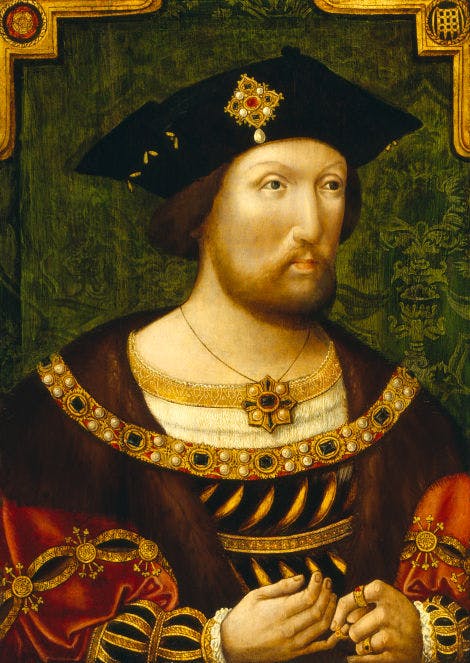
Image: King Henry VIII by Unknown Anglo-Netherlandish artist, c1520, © National Portrait Gallery London
Henry VIII's quest for a son
Glorious victories on the battlefield and magnificent European summits were all very well, but Henry VIII needed a son and heir to ensure the future of the Tudor dynasty and to avoid ensuing bloody competition over the crown.
In a world dominated by war and men, countries ruled by women were considered vulnerable to being acquired by others through marriage. It was a king's principal responsibility to secure the peace and prosperity of his realm by having a son – a king-in-waiting.
Katherine’s first miscarriage occurred early in her marriage. She then gave birth to a son, christened Henry, on 1 January 1511. However, the couple’s joy was brief; the baby prince died within weeks.
In 1516, Katherine gave birth to Princess Mary, later Mary I, but at least five other pregnancies ended in a heart-breaking series of miscarriages and still-births.
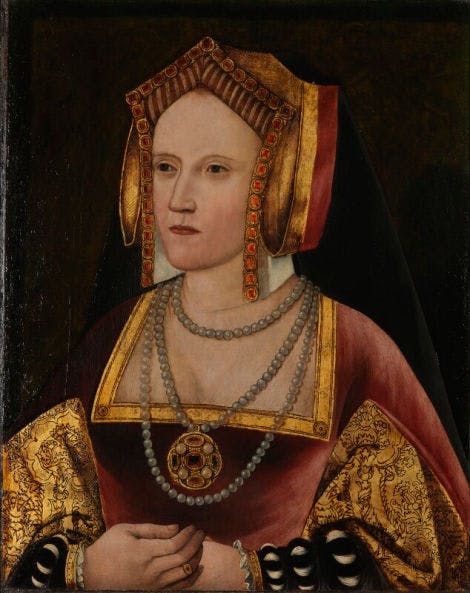
Image: Katherine of Aragon, by an unknown artist, in about 1520, reproduced by kind permission of His Grace the Archbishop of Canterbury and the Church Commissioners
A cursed marriage?
As time passed, hopes of an heir began to fade. There were also other changes in the once strong marriage. Katherine turned 40 in 1525. She withdrew from the lively court life that Henry still enjoyed, becoming increasingly pious and devout.
Henry began to worry that his marriage might be cursed, as he had angered God by marrying his brother’s widow. He became obsessed with a quote from The Old Testament: ‘If a man takes his brother’s wife, it is impurity; he has uncovered his brother’s nakedness, they shall be childless.’ [Leviticus XX,21]
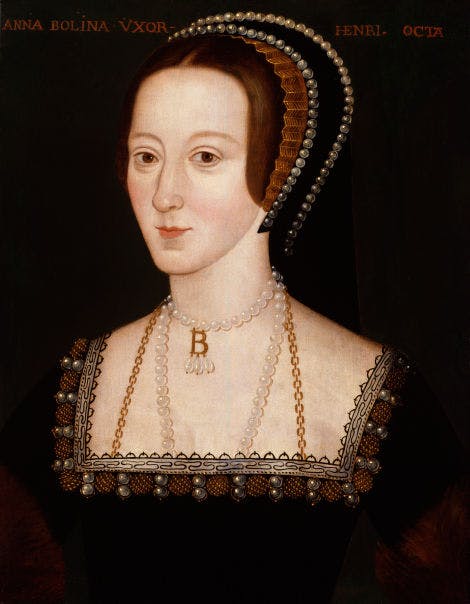
Image: Anne Boleyn, by an unknown artist in the late 16th century, probably copied from a lost original portrait, © National Portrait Gallery
Henry meets Anne Boleyn (married 1533-36)
In 1526, Henry VIII fell in love with a younger woman. Anne Boleyn was charismatic, self-confident and unobtainable.
The King may have desired her as a mistress, but Anne held out for a greater prize.
Henry would need to divorce Katherine of Aragon before he could have Anne.
Anne was seen by some as a key, and unwelcome, influence on the King. Henry VIII's chief minister and close advisor Cardinal Wolsey, called her 'the night crow', cawing into the King's ear in the intimacy of night.
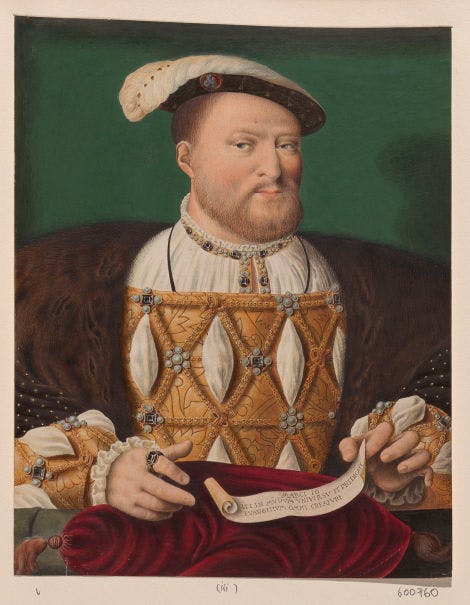
Image: Portrait of Henry VIII, by Joos van Cleve, c1530-5, Royal Collection Trust / © Her Majesty Queen Elizabeth II, RCIN 600760
I promise … to take you as my sole mistress, casting off all others than yourself out of mind and affection, and to serve you only.
From a series of love letters from Henry to Anne, written in the late 1520s and now preserved in the Vatican Archives.
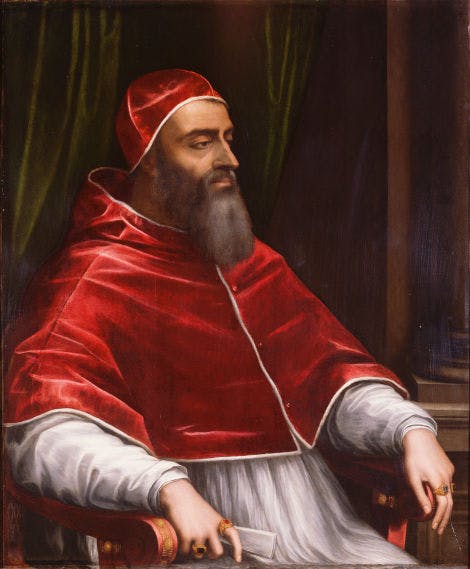
Image: Pope Clement VII, painted in about 1531 by Sebastiano del Piombo. Digital image courtesy of the Getty's Open Content Program
Mid-length portrait of a man sat down facing off to the side. He wears a hat and cape with a gown underneath and holds a note in his hand.
The 'Great Matter'
However, while Henry may have been longing to marry Anne, he couldn't free himself as quickly as he hoped from his first marriage. It took seven years for him to rid himself of his first wife. So all-consuming was Henry's desire for a divorce that it became known as the King's 'Great Matter'. Katherine resisted, and without her consent, Henry needed the Pope to grant him a divorce.
Katherine’s nephew was the Holy Roman Emperor Charles V, the most powerful ruler in Europe, and Charles controlled the Pope. Only Henry VIII’s force of will and use of his executive royal power made it possible. Encouraged by Protestant reformers who denied the authority of the Pope, Henry declared his independence from Rome in a series of Acts passed between 1532 and 1534.
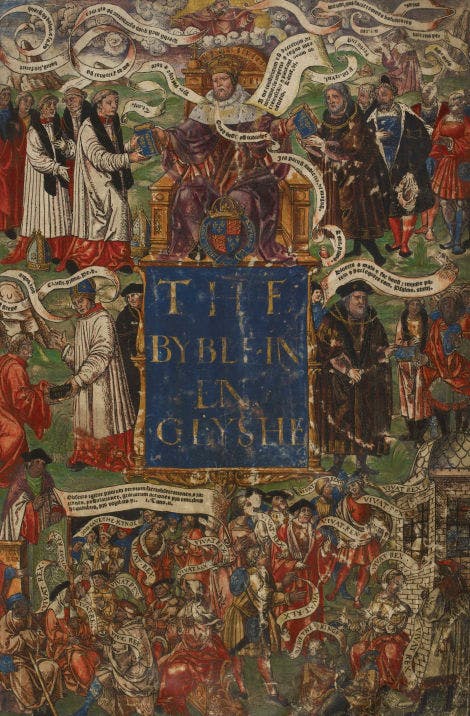
Image: Title page of the second “Great Bible”, also known as Cranmer's Bible, London, 1540. This particular Bible with its coloured title page was very probably Henry VIII’s personal copy. © British Library Board, C.18.d.10
Henry's break with Rome
Running out of patience with the fruitless negotiations with the Pope, Henry announced that his marriage with Katherine had never been valid, because of her previous relationship with his brother, Prince Arthur.
Thomas Wolsey, Henry’s chief minister and right-hand man in the 1520s, lost Hampton Court to the King in 1529 after he failed to solve the King’s ‘great matter’. He died, stripped of all his royal offices the following year.
Henry married Anne Boleyn in January 1533 after his marriage to Katherine of Aragon was declared 'null and void' by the obliging Archbishop of Canterbury, Thomas Cranmer. Anne was crowned on 1 June 1533. The following year, the Act of Supremacy declared Henry 'the Supreme Head on earth of the Church of England'.
Katherine of Aragon was left bereft, forbidden even to see her daughter Mary. She died three short years later.
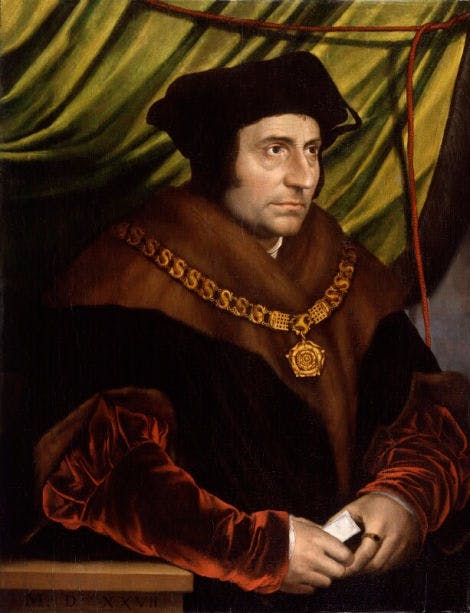
Image: Sir Thomas More, a painting based on an original portrait by Hans Holbein the Younger, c1527, © National Portrait Gallery, London
When the King roars...
Henry by now felt himself unstoppable. He insisted all acknowledge him, rather than the Pope, as God’s representative on earth. All those who refused were destroyed, including his chancellor, Thomas More, who was executed at the Tower of London in 1535.
However, the King's volatile temper meant that even his supporters needed to be careful. As More warned:
"You often boast to me that you have the King’s ear and have fun with him, freely... This is like having fun with tamed lions – often it is harmless, but just as often there is fear of harm. Often he roars in rage for no known reason, and suddenly the fun becomes fatal."
(Latin Poems, #162, "To a Courtier")
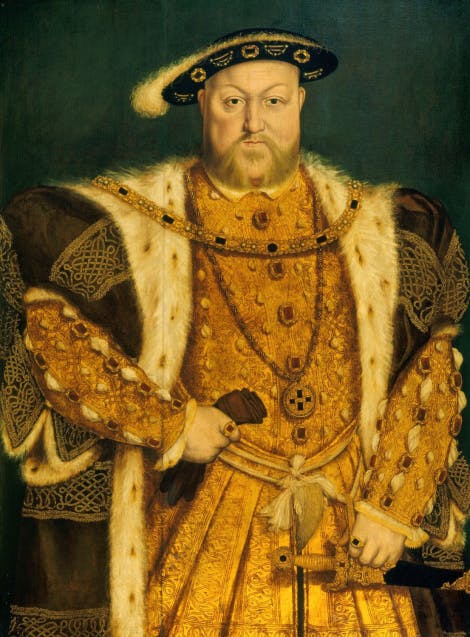
Image: Henry VIII, by an unknown artist, copied, probably during Henry VIII's lifetime, from a portrait by Hans Holbein the Younger, Royal Collection Trust / © Her Majesty Queen Elizabeth II, RCIN 404438
Dissolution of the monasteries
Responding to Henry’s assumption of power over his own 'Church of England', the Pope excommunicated the King in 1533.
But Henry was not to be dissuaded, attracted by the chance to seize the huge amount of wealth and property owned by the Catholic Church in England.
Between 1536 and 1540, in a campaign led by the King's ambitious chief minister Thomas Cromwell, Henry seized land and treasures and destroyed or closed over 800 monasteries and other religious houses – the monks and nuns accused of ‘vicious, carnal and abominable sin.
What did Henry do with the money?
Henry stored much of the vast fortune in the royal treasury, or gifted it to his new ministers, ensuring their loyalty.
He also used the money to develop England’s navy and build new dockyards; he improved the machinery of central and local government and patronised innovation in science and the arts.
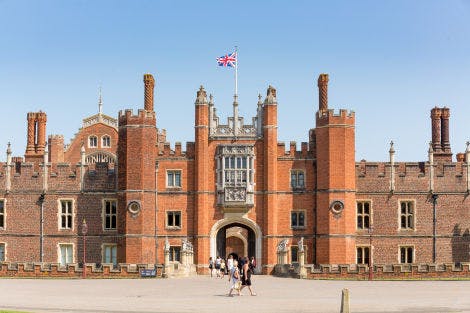
Image: The Gatehouse at Hampton Court Palace. © Historic Royal Palaces
Henry VIII's Hampton Court Palace
When Henry VIII seized the wealth of the Catholic church in England, he became possibly the richest monarch in English history. He lavished some of his new-found wealth on palaces and treasures.
Henry VIII's most famous residence, Hampton Court Palace was devoted to pleasure, celebration and ostentatious display. When Henry finished his building programme in around 1540, Hampton Court was the most modern, sophisticated and magnificent palace in England.
The King's Apartments
The Great Hall and Chapel at Hampton Court survive as testament to Henry’s spectacular building programme and grand interior designs.
At some point during Henry VIII’s reign, all six of Henry’s wives visited Hampton Court and most had new and lavish lodgings. The King rebuilt his own rooms at least half a dozen times.
Many of Henry VIII’s sumptuous royal interiors were swept away when Hampton Court was rebuilt for William III and Mary II in 1700, but we can still glimpse his lost world in the surviving Tudor state apartments at the palace.
Henry VIII commissioned fabulous tapestries for the walls of his palaces, woven with silk and gold thread that glittered in the candlelight. By his death, the King owned over 2,000 tapestries. Chief among them all were the ‘Abraham’ tapestries, which still survive at Hampton Court today.
The Chapel Royal
Henry's last great building project at the palace, the Chapel Royal was begun in 1535. The most important change was the addition of the fantastical ceiling, which still survives. The ceiling's components were carved at Sonning, several miles further up the River Thames, before being transported to Hampton Court and reassembled there.
The Great Watching Chamber
The Great Watching Chamber got its name from its position beyond the Great Hall, where Yeomen of the Guard were stationed to ‘watch’ and control access into the more private royal apartments.
The Great Kitchens
In 1529-30, the capacity of the Great Kitchen to serve the meals eaten in the Great Hall was doubled and a second serving-place was added to the south, allowing twice as many waiters as before to carry food up to the Great Hall.
To its west three new small courtyards sprang up, surrounded by many specialised offices for boiling, pastry-making, fruits and spices. Confectioners worked in an upstairs room, producing delicate sweets and comfits on chafing dishes.

Henry VIII's lost gardens at Hampton Court
Explore Henry VIII's cherished garden retreat, through a collection of 16th-century treasures
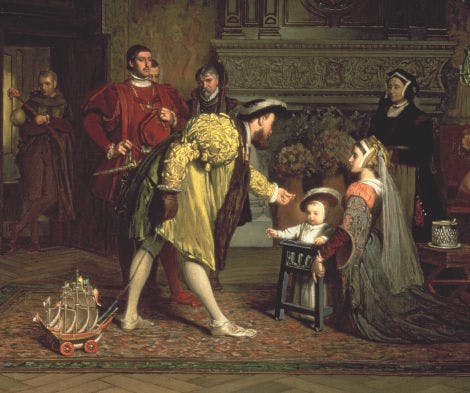
Image: This imagined scene of Henry as a devoted father was painted by Marcus Stone in the 19th century. The Royal Nursery, Forbes Magazine Collection, New York, USA / Bridgeman Images
Birth of Elizabeth I
In 1533, as building works for new royal apartments at Hampton Court progressed, Anne Boleyn’s first child – the future Queen Elizabeth I – was born at Greenwich on 7 September.
Henry and Anne were so confident that their first child would be a son that they wrote the birth announcement in advance. Letters were sent out immediately after the birth of the future Elizabeth I on 7 September 1533, but with a vital amendment. They thanked God for sending the Queen good speed in the deliverance and bringing forth of a prince. Hastily an extra 's' was added to announce the birth of a ‘princes'(princess).

Image: Anne Boleyn in the Tower of London by Édouard Cibot (1799-1877), © Heritage Image Partnership Ltd/Alamy Stock Photo
The death of Anne Boleyn
Three years later, Henry VIII was still without a male heir.
Anne Boleyn's 'failure' to produce a son became the fatal catalyst for her spectacular downfall.
Vicious rumours spread by surviving supporters of the old Catholic regime accused Anne of adultery and plotting the King’s death.
Despite her protestations of innocence, Henry ordered Anne to the Tower of London. After a sham trial, she was executed for treason on 19 May 1536.
Henry allowed Anne a small mercy for her execution. At her request, Anne was beheaded cleanly with a sharp sword, rather than an unreliable axe.
Read more: Henry VIII's children
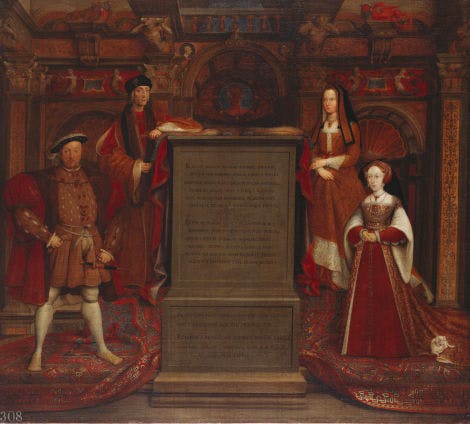
Image: Henry VIII’s new confidence in the future of the Tudor dynasty was immortalised by Hans Holbein in a life-size mural at Whitehall Palace in 1537. The original painting was destroyed by fire, but this 17th-century copy (detail) by Remigius van Leemput survives, showing Henry VIII, Jane Seymour and Henry’s parents, Henry VII and Elizabeth of York. Royal Collection Trust/© Her Majesty Queen Elizabeth II, RCIN 405750
Marriage to Jane Seymour
Even before the execution of Anne Boleyn, Henry had already selected his third wife – Jane Seymour was one of Anne’s ladies-in-waiting.
The King married Jane Seymour at Whitehall Palace only ten days after Anne’s death. In 1537, the future Edward VI was born in the early hours of 12 October at Hampton Court, and was christened three days later in the Chapel Royal. Tragically, post-natal complications led to Jane’s death at the palace on 24 October.
For Henry, the birth of a son validated all his previous political and religious choices. He now had God’s approval.
The Tudor tyrant
Henry's religious policies met with opposition in the wider country, which he ruthlessly crushed. In 1536, he had mercilessly executed the leaders of the reactionary ‘Pilgrimage of Grace’, a social protest about the King’s religious revolution and its economic impact.
In 1539, the Act of Proclamations gave full legal authority to all his commands. Discriminatory laws were also passed against witchcraft and homosexuality, which had terrible consequences for many innocent people persecuted over the next two hundred years. Henry had become a tyrant.
Did you know?
Henry had an illegitimate son, born in 1519 to Elizabeth Blount, one of Katherine of Aragon’s maids. Henry Fitzroy, made Duke of Richmond and lavishly spoiled, died in 1536.

Image: Henry VIII, by Hans Holbein the Younger, c1537, © Museo Nacional Thyssen-Bornemisza, Madrid
Sportsman, musician and collector
Henry VIII’s brutish self-confidence, his ruthless management style, and of course his six wives, fascinate us today.
But Henry was more than just a caricature of a tyrant king.
He was intelligent, a linguist, sports-mad, fashion-conscious, a fine musician and song-writer, and culturally sophisticated.
The rich interiors of Hampton Court, Whitehall and the great lost palace of Nonsuch were filled with important furnishings, artworks and all kinds of Renaissance marvels, commissioned from English, Netherlandish, German, French and Italian artists and craftsmen, including jewellery, musical instruments and illuminated manuscripts.
The royal wardrobe boasted a luxurious and shimmering collection of silks, velvets and furs, encrusted with precious stones.
Watch: Henry VIII's favourite sport
Jousting was the most prestigious of all tournament sports in the Tudor period, and a favourite of Henry VIII's.
In this video, Curator Charles Farris talks to Mark Griffiths about the rules, armour, tactics, and dangers of this expensive and prestigious sport.
This content is hosted on YouTube
This content may be using cookies and other technologies for which we need your consent before loading. To view the content, you need to enable cookies for "Targeting Cookies & Other Technologies".
Manage CookiesIn this video, Curator Charles Farris talks to Mark Griffiths about the rules, armour, tactics, and dangers of this expensive and prestigious sport.
Video transcript
Follow along with an interactive transcript on YouTube. A link to open the transcript can be found in the description.

Image: Portrait of Anne of Cleves by Hans Holbein the Younger, 1539, © Louvre, Paris, France / Bridgeman Images
Marriage to Anne of Cleves
Despite the birth of Prince Edward, Henry VIII knew that the future of the Tudor dynasty remained fragile.
He needed spare heirs, and in 1540, his chief minister Thomas Cromwell persuaded him to marry Anne of Cleves, a German princess, a political match who would provide England with new allies in Europe.
The following events were a cataclysmic disaster.
Henry rejected Anne, declaring ‘I like her not’, bought off the compliant Anne, and hurriedly married one of her ladies-in-waiting, the teenaged Catherine Howard. The King had always preferred to choose his wives for himself.
Cromwell was executed on the same day.

Image: A portrait of a 17-year-old Tudor courtier, possibly Catherine Howard, painted in the workshop of Hans Holbein the Younger, c1540-5. Courtesy of The Metropolitan Museum of Art.
Marriage to Catherine Howard
Over the New Year celebrations of 1541, Henry showered Catherine Howard with presents, as he revelled in the attentions of a much younger wife. By the end of the year, the atmosphere had completely changed. Thomas Cranmer anxiously presented the King with evidence of Catherine’s infidelity and adultery. Henry’s anger was, even for him, remarkable: some of his courtiers thought he had gone mad.
The Queen was arrested at Hampton Court and later taken to the Tower of London. She would not see the King again before her execution on 13 February 1542.
Legend has it that the ghost of a terrified Catherine Howard haunts the State Apartments at Hampton Court, running to the Chapel to plead for mercy with Henry VIII.
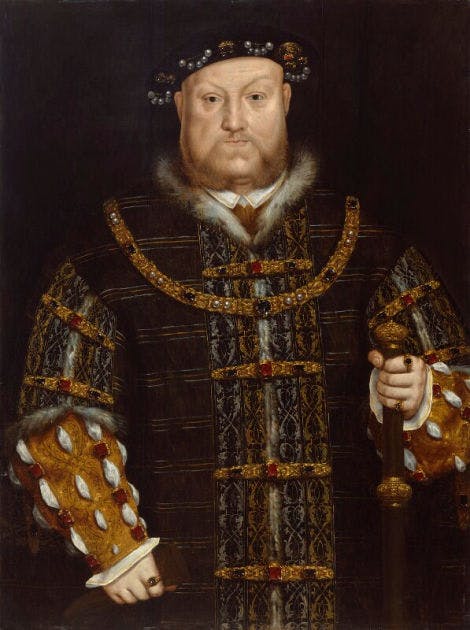
Image: Henry VIII by an unknown artist, based on a work of c1542, © National Portrait Gallery, London
Henry's Illness and decline
By the 1540s, Henry VIII was no longer an athletic ‘Renaissance Prince’.
A bad injury in 1536, after he had fallen from his horse at a joust, and a recurring leg ulcer restricted him physically.
Some historians suggest that this accident, after he was unconscious for over two hours, had long-lasting psychological effects on the King. They point to evidence of a change in his personality after 1536, and his increasingly tyrannical behaviour.
Henry remained in constant pain from his leg ulcer, and he continued to eat as though he was a fit young man. In his early twenties, Henry VIII’s waist measured 89 cm. By the age of 50, it had expanded to 137cm.
His weight ballooned to the stage where he needed a form of wheelchair – known as a ‘tramme’ to get about. He even had a handwritten book of remedies for medical treatments created between 1540 and 1545.
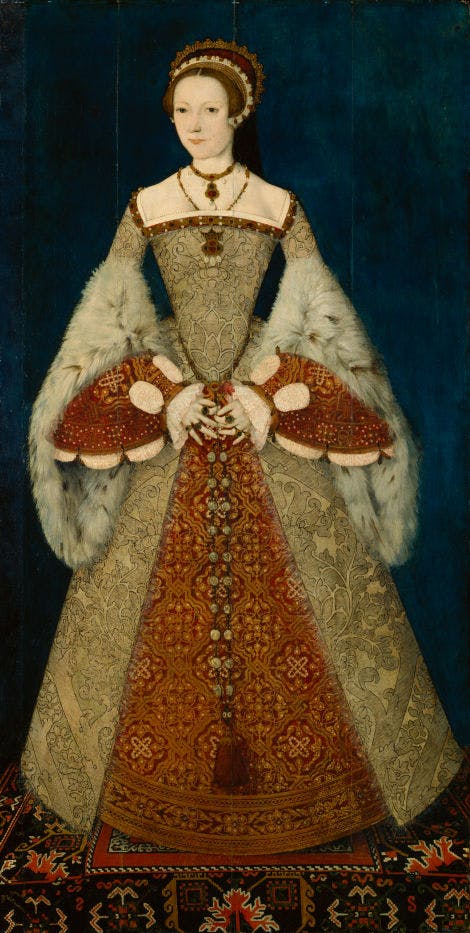
Image: Katherine Parr, attributed to Master John, c1545. © National Portrait Gallery, London
Marriage to Katherine Parr
Ever since the break with the Church of Rome, reformers and conservative factions at court had argued about how far Henry VIII’s ‘reformation’ ought to go.
Henry’s last wife, Katherine Parr, was a committed Protestant. The King’s marriage to Katherine, at Hampton Court on 12 July 1543, heralded a three-year battle for the identity of the Church of England.
The conflict almost claimed Katherine’s life, accused by her opponents of heresy, but saved by her supporters and by an ageing king, who – for once – sided with his wife.
Twice-widowed Katherine was blessed with matrimonial experience and tact, essential qualities for managing an ailing and irascible king.
Apart from being the only wife to survive Henry, perhaps Katherine’s greatest achievement was to be the first queen of England to write and publish her own books. She was also an active patron of the arts.
Henry VIII's final years
Henry’s break with the Church of Rome was a religious and political revolution. But at the same time, some things hadn’t changed. Men still got rich and powerful by getting close to the King, and Henry continued to rely on key courtiers and ministers, as well as Parliament, to pass laws that validated his authority and provided him with money.
One of Henry VIII’s defining ambitions was his rivalry with the French king, Francis I. He sought to turn England from a minor power on the world stage to a force to be reckoned with. In the 1540s, Henry returned to the battlefield, accompanying his army on another campaign against France, leading to the capture of Boulogne in 1544. But the following year, a French raid on the English coast left Henry’s flagship, the Mary Rose, at the bottom of the Channel.
Did you know?
Henry relied on Katherine to run the country during his absence at war in France in 1544. Katherine assumed the role of Queen Regent-General of England and signed five royal proclamations.
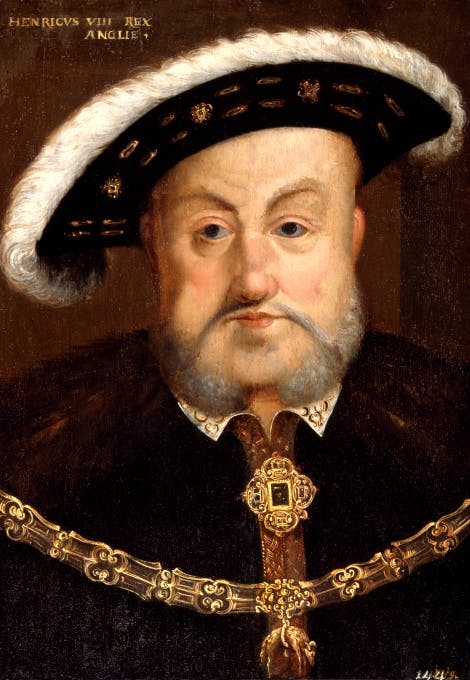
Image: A copy of a late portrait of Henry VIII. © National Portrait Gallery
The death of Henry VIII
How did Henry VIII die?
Historians still speculate on the cause of Henry VIII's death, but his obesity doubtless contributed to his remorseless decline and organ failure. Despite rallying after his marriage to Katherine Parr, Henry ‘waxed heavy with sickness, age and corpulence’.
From his deathbed at Whitehall Palace, Henry VIII uttered his last recorded words when asked which priest should attend him: 'I will first take a little sleep, and then, as I feel myself, I will advise upon the matter.'
The following morning, Henry had lost the power of speech.
Despite the massive religious and social upheaval of the Reformation, it comes as a surprise to discover that Henry VIII remained conservative in his beliefs and died a Catholic.
When did Henry die?
Henry VIII died in the early hours of 28 January 1547, aged 55.
The next day, Prince Edward (the new Edward VI) and Princess Elizabeth were told of their father’s death. Reportedly, the children, aged 9 and 16, clung to each other weeping, fearful for their future.
Where is Henry buried?
Henry VIII was buried next to Jane Seymour, in St George’s Chapel at Windsor Castle.
Read more: The Extravagant Funeral of Henry VIII
What happened after Henry's death?
The reigns of Henry VIII's children were riven by religious dispute and uncertainty. The arguments between reformers and conservatives continued long after the King's death.
The crown passed into the hands of Edward VI, Lady Jane Grey and then Mary I. Finally, after all of Henry’s efforts to secure a long-lasting royal line, his dynasty ended with Elizabeth I, who died single and without an heir in 1603.
The crown passed to James VI of Scotland, a great-great grandson of Henry VIII’s father, Henry VII. James became the first monarch of the Stuart dynasty to rule over England, as James I.

Image: The Family of Henry VIII (detail), c1545, British School.
This important dynastic portrait of Henry VIII and his family shows the king seated in the centre beneath a canopy of state flanked by his third wife, Jane Seymour and Prince Edward, later Edward VI.
On the left is Princess Mary, later Mary I, the king’s daughter by his first wife, Catherine of Aragon, and on the right Princess Elizabeth, later Elizabeth I, his daughter by his second wife, Anne Boleyn.
Royal Collection Trust/© Her Majesty Queen Elizabeth II, RCIN 405796
Henry VIII's legacy
Of all British kings and queens, Henry VIII remains one of the most familiar and controversial. His search for wedded bliss alone makes him extraordinary, but there was so much more to the King and his age.
Like him or loathe him, in many ways Henry VIII created modern Britain.
By marrying Elizabeth of York, his father Henry VII had united the warring Houses of Lancaster and York and brought financial stability, but this wasn’t enough.
England needed a strong ruler in the early 1500s, someone who would prevent the country from slipping back into the endless, ruinous civil wars of the past and establish a modern and efficient nation-state. Henry VIII was such a king.
Back in 1521, Henry wrote a book attacking the arch reformist Protestant Martin Luther, which had earned him the title ‘Defender of the Faith’ from the Pope. This title is still used by the British sovereign today.
As well as establishing the Church of England, he authorised the translation and publication of the Bible in English.
His dissolution of the monasteries created a land market and a source of economic prosperity for a new ‘middle class’ of lawyers and administrators.
Henry’s development of the navy would ultimately lead to a British ‘golden age’ of colonial expansion and imperial power.
On the other hand, Henry VIII could be vicious, paranoid, self-pitying and vainglorious. Many of his actions were motivated by self-interest, and his failures were never his fault.
Henry ruled by proclamation as well as through Parliament and courtiers (and his wives) lived or died at his command.
The Church of England was not the achievement of a reforming visionary, but a political necessity, designed to secure him a new wife.
Discover more about Henry VIII

Explore Henry VIII's Palace
Virtual Tour
Discover more about Hampton Court Palace during the reign of Henry VIII with our interactive story, created in partnership with Google Arts & Culture.
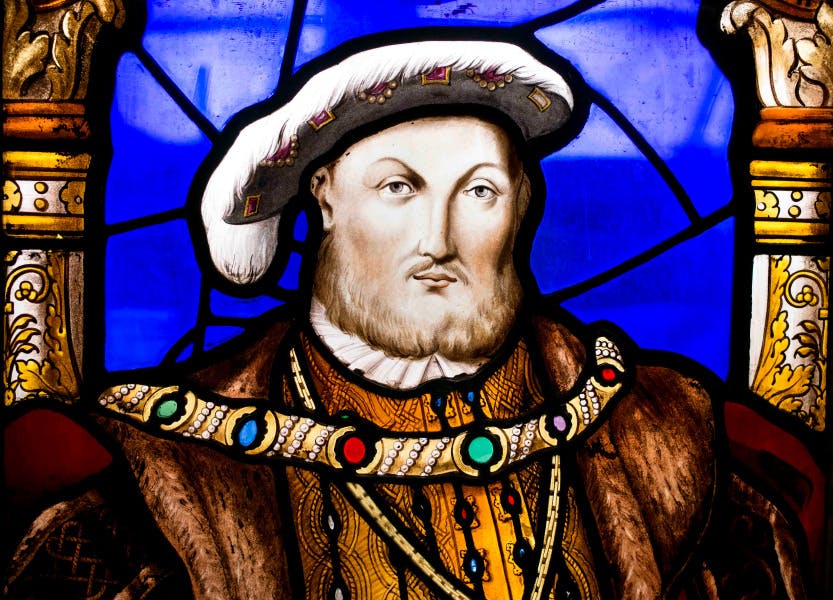
Test your knowledge on Henry VIII
Play the Royal History Quiz online
Think you know all about this notorious king? Put your knowledge to the test with our fun quiz! Whether you are a history enthusiast or curious learner, the Royal History Quiz is your gateway to exploring the past. Take the challenge now and see if you have what it takes to wear the crown!
Browse more history and stories

Henry VIII's Lost Gardens at Hampton Court
Discover a vast, glittering complex of lost Tudor buildings

The Field of Cloth of Gold
Henry VIII's historic meeting with his great rival François I in 1520 was a defining point in his reign

The Elizabethan era: a golden age?
Was the Elizabethan period really a 'golden era' of English history?
Explore what's on

- Things to see
Wolsey Closet
Explore this hidden Tudor space, the only surviving room of the apartment that Cardinal Wolsey had built for Henry VIII.
-
Open
- In line with palace opening hours
- Hampton Court Palace
- Included in palace admission (Members go free)

- Things to see
Haunted Gallery and Processional Route
Walk Henry VIII’s route from his private apartments to the Chapel and see the infamous Haunted Gallery in the State Apartments.
- Open
- In line with palace opening hours
- Hampton Court Palace
- Included in palace admission (Members go free)

- Things to see
Great Hall
Experience the splendour of the Tudor court in Henry VIII's Great Hall, complete with his magnificent tapestries.
- Open
- In line with palace opening hours
- Hampton Court Palace
- Included in palace admission (Members go free)
Shop online

Christmas homepage banner - Henry VIII and Six Queens Decoration Set
Christmas Homepage Banner - Henry VIII and Six Queens hanging decoration set on a Christmas tree at Hampton Court Palace.
£70.00
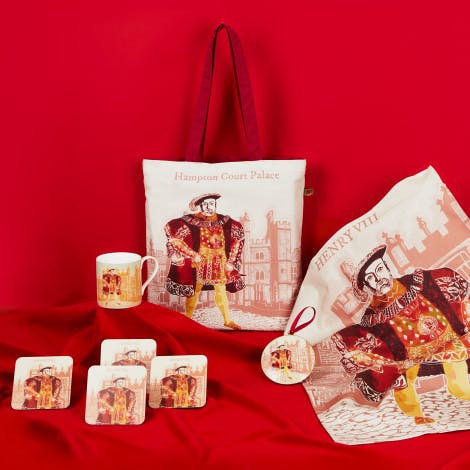
Shop Tudors
Find the perfect gift for collectors and history enthusiasts in our treasure trove of souvenirs inspired by this ever-fascinating dynasty.
From £3.00

Shop Goblets & Tankards
Discover our decadent range of goblets and tankards inspired by the palaces in our care, the perfect gift for any history fan.
From £10.00
